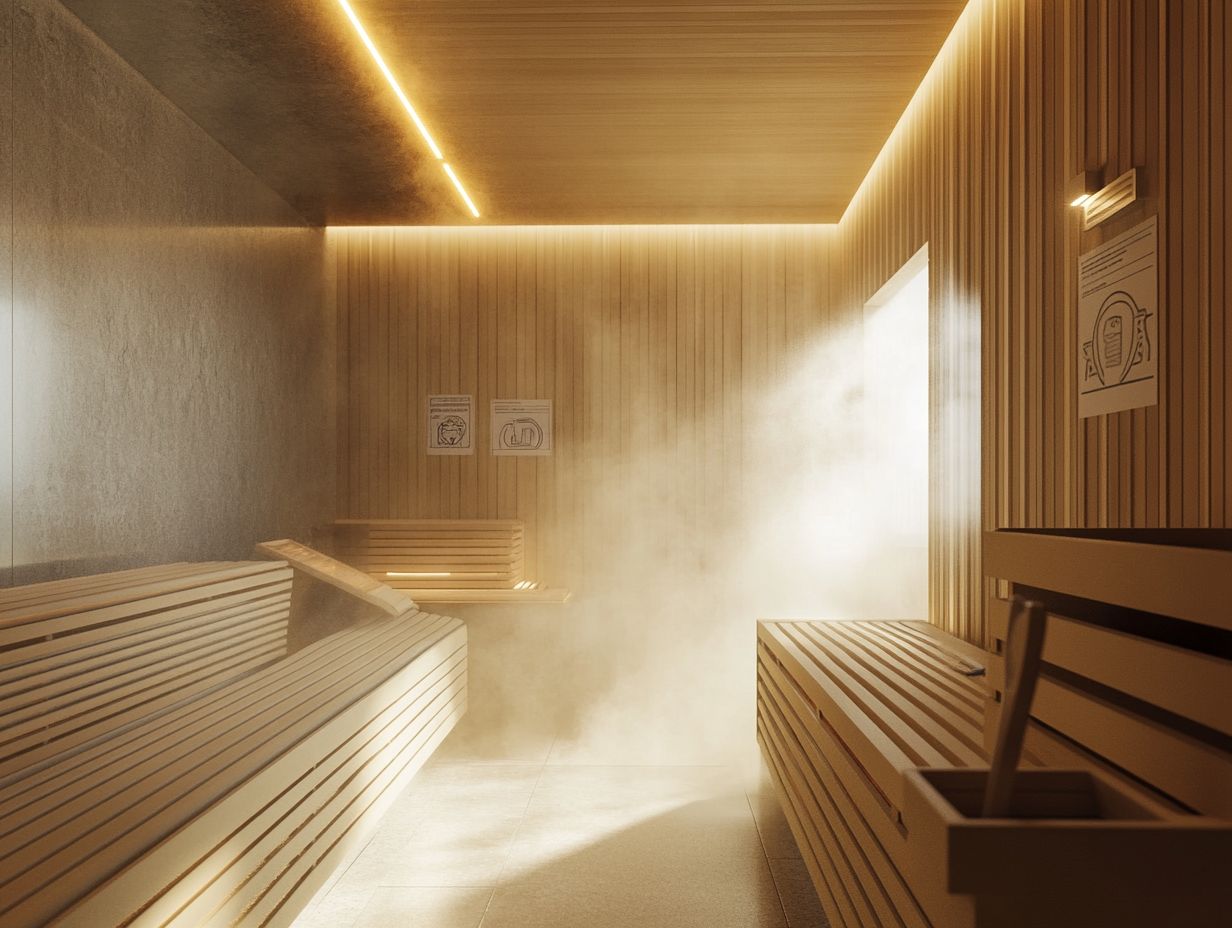Maintaining Safety Standards in Sauna Facilities
Saunas aren t just a treat; they re a journey to wellness! They provide a distinctive fusion of relaxation and health benefits, yet ensuring your safety in these steamy sanctuaries is of utmost importance.
Understanding the different types of saunas and acknowledging potential hazards is crucial to upholding safety standards. Proper ventilation, cleanliness, and well-trained staff contribute significantly to a secure sauna experience.
This article delves into essential aspects of sauna safety, empowering you to enjoy your time in these tranquil spaces with complete peace of mind.
Contents
- Key Takeaways:
- What is a Sauna?
- Importance of Maintaining Safety Standards
- Ensuring Proper Ventilation
- Maintaining Cleanliness and Hygiene
- Safety Features to Look for in Saunas
- Staff Training and Emergency Protocols
- Frequently Asked Questions
- What are the main safety standards that should be maintained in sauna facilities?
- Why is proper ventilation important in sauna facilities?
- How often should sauna equipment be inspected and maintained?
- What are the recommended cleaning and sanitization procedures for sauna facilities?
- What emergency response equipment should be available in sauna facilities?
- Can sauna facilities be used by pregnant women?
Key Takeaways:

- Always ensure proper ventilation for a safe sauna experience! This includes maintaining airflow and temperature control to prevent potential health risks.
- Cleanliness and hygiene are essential in sauna facilities to prevent the spread of bacteria and viruses. Establish proper cleaning and disinfection procedures to keep users safe and healthy.
- Ensure saunas have necessary safety features, such as emergency shut-off switches and temperature sensors, to prevent accidents. Staff should be trained in emergency protocols to ensure the safety of all users.
What is a Sauna?
A sauna is more than just a room; it’s an experience designed for enjoying dry and wet heat. Often featuring warm wooden accents, saunas elevate the ambiance.
You ll find various types of saunas, including barrel saunas, steam rooms, and infrared saunas. Each offers unique health benefits, relaxation, and therapeutic advantages.
Generally, temperatures range from 150 F to 195 F, accompanied by varying humidity levels. Understanding the different types and their functions will empower you to fully appreciate the multitude of health benefits these soothing environments can provide.
Definition and Types of Saunas
Saunas present a fascinating array of options, including barrel saunas, steam rooms, and infrared saunas. Each offers distinct experiences and health benefits tailored to your needs.
Barrel saunas, often crafted from wood, create a warm and rustic atmosphere while efficiently using heat. They allow for direct ventilation that enhances your overall experience. If you prefer a humid escape, steam rooms are characterized by high humidity and elevated temperatures, known for their skin-hydrating properties and respiratory relief. They are perfect for those in pursuit of deep relaxation.
On the other hand, infrared saunas use special light to create heat, penetrating the skin more deeply. They provide a lower temperature alternative that’s incredibly effective for detoxification and soothing sore muscles. Each type caters to diverse preferences, ensuring you can discover the ideal setting to unwind, rejuvenate, and enjoy holistic health improvements.
Importance of Maintaining Safety Standards
Maintaining safety standards in sauna usage is crucial for preventing potential health risks and ensuring a secure environment for everyone, especially vulnerable groups like children and individuals with high blood pressure.
If you have any pre-existing conditions, it’s advisable to consult a doctor before using the sauna. Additionally, make safety inspections a regular practice. Take necessary precautions to avoid hazards such as dehydration, heat exhaustion, and improper supervision.
This way, sauna enthusiasts can fully enjoy the benefits while minimizing any associated risks.
Potential Risks and Dangers
While saunas offer many health benefits, it’s essential to acknowledge the potential risks, such as dehydration, heat exhaustion, and heatstroke. This awareness ensures a safe and enjoyable experience.
Recognizing these dangers is crucial for users, especially children and those with existing health issues. Prolonged exposure to high temperatures can lead to health complications, with studies showing that dehydration can set in rapidly sometimes in as little as 15-20 minutes.
Specific risks, including heat-related illnesses, call for vigilant supervision, especially for vulnerable individuals. Statistics indicate that young children are particularly sensitive to the adverse effects of elevated heat, making it vital for caretakers to monitor them closely in such environments.
By maintaining proper hydration and drinking enough water before and after sauna usage, along with following safety protocols, you ll enjoy a much safer sauna experience!
Ensuring Proper Ventilation

Proper ventilation in saunas is essential for maintaining a balanced and healthy environment. It ensures efficient airflow and temperature control, directly influencing your comfort and safety.
Adequate humidity levels and airflow not only enhance your sauna experience but also minimize the risks associated with inadequate ventilation. This makes regular inspections a crucial practice for all sauna facilities, safeguarding your well-being while you relax.
Importance of Airflow and Temperature Control
Airflow and temperature control in saunas are vital for a safe and enjoyable experience. When conditions are off, discomfort and health issues can arise quickly.
Understanding the interplay between airflow, temperature, and humidity can significantly enhance your sauna experience. Proper ventilation ensures a steady influx of fresh air, preventing excessive heat and moisture buildup. When temperatures soar or humidity levels go unchecked, you might find yourself grappling with dehydration or heat exhaustion, raising valid health concerns.
A well-ventilated sauna cultivates a more pleasant environment, allowing you to fully unwind and reap the benefits of heat exposure. This includes enhanced circulation, muscle relaxation, and effective detoxification. Embracing these elements can transform your sauna session into a revitalizing experience.
Maintaining Cleanliness and Hygiene
Keeping your sauna clean is crucial. It prevents harmful bacteria, like Staphylococcus aureus a type of bacteria that can cause infections and ensures a great experience for everyone.
Regular cleaning is a must, along with using appropriate cleaning products and effective disinfection procedures. Maintaining hygiene standards also involves proper maintenance practices and utilizing disposable tools when necessary.
This attention to detail safeguards health and enhances the overall sauna experience.
Proper Cleaning and Disinfection Procedures
To keep your sauna safe and clean, follow proper cleaning and disinfection procedures. This protects everyone from potential health hazards.
It s vital to use high-quality cleaning products specifically formulated for sauna materials, alongside effective tools like microfiber cloths and disposable wipes. Start by removing any visible debris or organic matter from surfaces, then apply a suitable disinfectant that adheres to industry hygiene standards.
Regularly inspecting and maintaining equipment such as benches and flooring is equally important. A thorough sanitizing routine not only ensures a pleasant experience but also curbs the growth of bacteria and mold, enhancing overall safety for everyone who enjoys the sauna.
Safety Features to Look for in Saunas
When choosing a sauna, it s essential to evaluate a range of safety features that protect users and elevate the overall experience. Effective supervision measures and regular inspections should be top of mind.
Key safety elements to look for include:
- The availability of fire extinguishers to prevent incidents,
- The selection of high-quality materials,
- The craftsmanship involved in the sauna’s construction for longevity.
Prioritizing these aspects ensures a safe and enjoyable environment for everyone.
Key Safety Features and Their Functions

Key safety features in saunas encompass adequate ventilation, fire extinguishers, and well-defined supervision protocols. These elements are essential in creating a healthy space and preventing potential hazards.
Proper ventilation regulates humidity levels and air quality, ensuring your sessions are comfortable and enjoyable. Fire extinguishers act as a crucial safety net, while clear supervision protocols guarantee that trained personnel are always available to address any concerns.
Integrating these safety features makes your sauna both safer and more inviting, allowing you to unwind and fully embrace the benefits of sauna use.
Staff Training and Emergency Protocols
Staff training and well-defined emergency protocols are essential for ensuring user safety and equipping staff to respond adeptly to incidents.
Investing in proper training strengthens your risk management strategies and fosters a culture of safety and attentiveness that resonates with your patrons.
Preparing for and Responding to Emergencies
Preparing for and effectively responding to emergencies involves establishing clear protocols and providing comprehensive training to ensure user safety during crises.
Setting up well-defined evacuation routes and conducting regular safety drills can make a significant difference when unexpected situations arise.
Recognizing signs of overheating or dehydration in users is crucial. Being equipped with the proper first aid supplies is also essential. Comprehensive training instills confidence among staff and gives them the power to manage potential risks adeptly, fostering a safer environment for everyone involved.
Frequently Asked Questions
What are the main safety standards that should be maintained in sauna facilities?
Main safety standards include proper ventilation, regular equipment maintenance, proper cleaning and sanitization procedures, and ensuring the availability of emergency response equipment.
Why is proper ventilation important in sauna facilities?

Proper ventilation is important to ensure a steady flow of fresh air and to prevent excessive heat and humidity. This helps maintain a safe and comfortable environment for sauna users.
How often should sauna equipment be inspected and maintained?
Sauna equipment should be inspected and maintained at least once a month to ensure safety and proper functioning. Any defects or malfunctions should be addressed immediately to prevent potential accidents.
What are the recommended cleaning and sanitization procedures for sauna facilities?
Wipe down all surfaces with a cleaning solution that kills germs. Keep floors free of debris and moisture, and replace towels regularly to prevent bacteria and viruses.
What emergency response equipment should be available in sauna facilities?
Have a first aid kit and a fire extinguisher readily available. Also, ensure a staff member trained in CPR is on site!
Can sauna facilities be used by pregnant women?
Pregnant women must consult their healthcare provider before using a sauna. Generally, it’s best to avoid saunas due to high temperatures and humidity, as they can be risky for both mother and baby.






